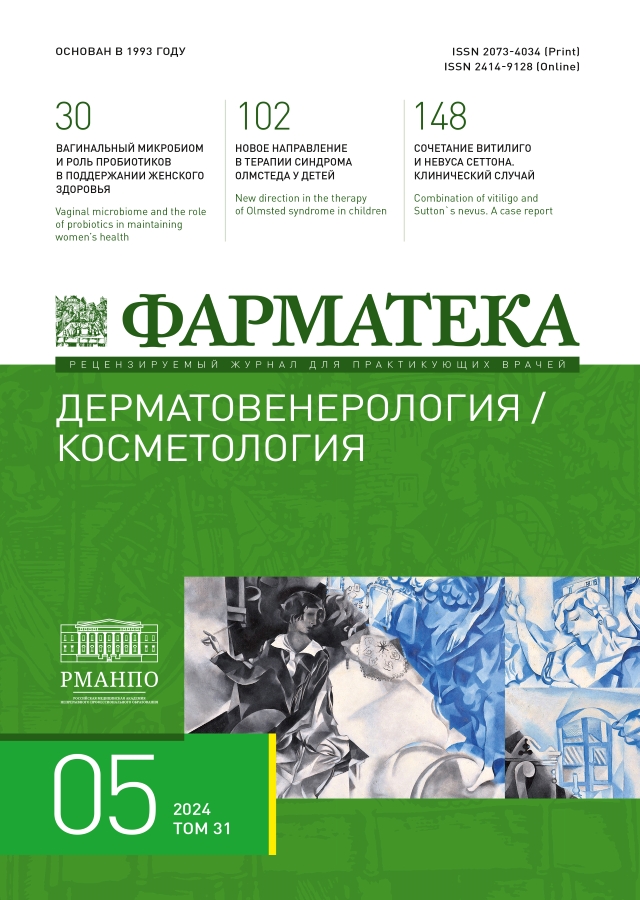New direction in the therapy of Olmsted syndrome in children
- Авторлар: Botkina A.S.1,2, Gumennaya E.R.2, Dubrovskaya M.I.1
-
Мекемелер:
- N.I. Pirogov Russian National Research Medical University
- Russian Children’s Clinical Hospital
- Шығарылым: Том 31, № 5 (2024)
- Беттер: 102-107
- Бөлім: New drugs and treatment approaches
- URL: https://journals.eco-vector.com/2073-4034/article/view/638379
- DOI: https://doi.org/10.18565/pharmateca.2024.5.102-107
- ID: 638379
Дәйексөз келтіру
Аннотация
Palmoplantar keratodermas are a heterogeneous group of inherited keratinization disorders of varying severity. Olmsted syndrome (OS) is one of the rarest diseases in this group, which is manifested by progressive mutilating keratoderma of the palms and soles, periorificial hyperkeratosis, and alopecia of varying severity. Most cases of OS arise as a result of pathogenic variants in the TRPV3 gene. In keratinocytes, TRPV3 forms a signaling complex with the epidermal growth factor receptor, which in turn leads to the activation of many downstream kinases, including serine-threonine kinase (mTOR), which is the main regulator of cell growth and proliferation. Enhanced activation of the mTOR pathway leads to various inflammatory, hyperproliferative and neoplastic diseases of the skin, including OS. There is currently no effective treatment for OS; topical, physiotherapeutic and medicinal agents do not have a significant clinical effect. The search for new pathogenetically substantiated treatment methods is an important task of modern dermatology. The article describes a clinical example of the first successful use of sirolimus in in a patient with OS in Russia.
Негізгі сөздер
Толық мәтін
Авторлар туралы
A. Botkina
N.I. Pirogov Russian National Research Medical University; Russian Children’s Clinical Hospital
Хат алмасуға жауапты Автор.
Email: botkina@gmail.com
ORCID iD: 0000-0001-6890-2041
Cand. Sci. (Med.), Associate Professor at the Department of Hospital Pediatrics n.a. Acad. V.A. Tabolin, Faculty of Pediatrics
Ресей, Moscow; MoscowE. Gumennaya
Russian Children’s Clinical Hospital
Email: botkina@gmail.com
Ресей, Moscow
M. Dubrovskaya
N.I. Pirogov Russian National Research Medical University
Email: botkina@gmail.com
ORCID iD: 0000-0002-3487-2451
Ресей, Moscow
Әдебиет тізімі
- Has C., Technau-Hafsi K. Palmoplantar keratodermas: clinical and genetic aspects. J Dtsch Dermatol Ges. 2016;14:123. doi: 10.1111/ddg.12930.
- Guerra L., Castori M., Didona B., et al. Hereditary palmoplantar keratodermas. Part I. Non-syndromic palmoplantar keratodermas: classification, clinical and genetic features. J Eur Acad Dermatol Venereol. 2018;32:704. doi: 10.1111/jdv.14902.
- Guerra L., Castori M., Didona B., et al. Hereditary palmoplantar keratodermas. Part II: syndromic palmoplantar keratodermas – Diagnostic algorithm and principles of therapy. J Eur Acad Dermatol. Venereol. 2018;32:899. doi: 10.1111/jdv.14834.
- Bukharia A., Komal S., Sudhanan V.M., Chaudhary S.S. Olmsted Syndrome: Rare Occurrence in Four Siblings. Indian J Dermatol. 2016;61(3):347. doi: 10.4103/0019-5154.182467.
- URL: https://omim.org/entry/614594.
- Lin Z., Chen Q., Lee M., et al. Exome sequencing reveals mutations in TRPV3 as a cause of Olmsted syndrome. Am J Hum Genet. 2012;90:558–64. doi: 10.1016/j.ajhg.2012.02.006.
- Butala S., Phan S., Siegel D.H., et al. Two for two: Dual therapy with erlotinib and acitretin for twins with severe keratoderma in Olmsted syndrome. Pediatr Dermatol. 2023;40(4):735–37. doi: 10.1111/pde.15264.
- Haghighi A., Scott C.A., Poon D.S., et al. A missense mutation in the MBTPS2 gene underlies the X-linked form of Olmsted syndrome. J Invest Dermatol. 2013;133(2):571–73. doi: 10.1038/jid.2012.289.
- Huang Y., Li J. Olmsted Syndrome. JAMA. Dermatol. 2024;160(2):218–19. doi: 10.1001/jamadermatol.2023.4152.
- Duchatelet S., Hovnanian A. Olmsted syndrome: clinical, molecular and therapeutic aspects. Orphanet J Rare Dis. 2015;10:33. doi: 10.1186/s13023-015-0246-5.
- Ogawa F., Udono M., Murota H., et al. Olmsted syndrome with squamous cell carcinoma of extremities and adenocarcinoma of the lung: failure to detect loricrin gene mutation. Eur J Dermatol. 2003;13:524–28.
- Wilson N.J., Cole Ch., Milstone L.M., et al. Expanding the phenotypic spectrum of Olmsted syndrome. J Invest Dermatol. 2015;135(11):2879–83. doi: 10.1038/jid.2015.217.
- Mevorah B., Goldberg I., Sprecher E., et al. Olmsted syndrome: mutilating palmoplantar keratoderma with periorificial keratotic plaques. J Am Acad Dermatol. 2005;53:S266–72. doi: 10.1016/j.jaad.2005.03.036.
- Wee P., Wang Z. Epidermal growth factor receptor cell proliferation signaling pathways. Cancers (Basel). 2017;9(5):E52. doi: 10.3390/cancers9050052.
- Liu G.Y., Sabatini D.M. mTOR at the nexus of nutrition, growth, ageing and disease. Nat Rev Mol Cell Biol. 2020;21:183–203. doi: 10.1038/s41580-019-0199-y.
- Dong J., Han D., Wang D., et al. Efficacy and safety of sirolimus in the treatment of vascular malformations: A protocol for systematic review and meta-analysis. Medicine. 2020;99:e22596. doi: 10.1097/MD.0000000000022596.
- Granata S., Dalla Gassa A., Carraro A., et al. Sirolimus and Everolimus Pathway: Reviewing Candidate Genes Influencing Their Intracellular Effects. Int J Mol Sci. 2016;17:735. doi: 10.3390/ijms17050735.
- Swarbrick A.W., Frederiks A.J., Foster R.S. Systematic review of sirolimus in dermatological conditions. Australas. J Dermatol. 2021;62(4):461–69. doi: 10.1111/ajd.13671.
- Zhang A., Duchatelet S., Lakdawala N., et al. Targeted Inhibition of the Epidermal Growth Factor Receptor and Mammalian Target of Rapamycin Signaling Pathways in Olmsted Syndrome. JAMA. Dermatol. 2020;156:196–200. doi: 10.1001/jamadermatol.2019.4141.
- Донюш Е.К., Кондрашова З.А., Поляев Ю.А., Гарбузов Р.В. Опыт использования сиролимуса в лечении детей с сосудистыми аномалиями. Российский журнал детской гематологии и онкологии (РЖДГиО). 2020;7(3):22–31. [Donyush E.K., Kondrashova Z.A., Polyaev Yu.A., Garbuzov R.V. Sirolimus for the treatment of vascular anomalies in children. Russian Journal of Pediatric Hematology and Oncology. 2020;7(3):22–31. (In Russ.)]. doi: 10.21682/2311-1267-2020-7-3-22-31.
Қосымша файлдар












